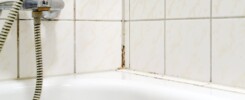At Remediation Mold Tampa, we know how overwhelming it can be to find mold or mildew in your home. While they might seem similar at first glance, mold and mildew are quite different and need to be handled in distinct ways. Understanding these differences can help you take the right steps to address the problem—and decide when it’s time to call in a professional.
What Are Mold and Mildew?
Both mold and mildew are types of fungi that thrive in damp, humid environments—conditions common in Florida homes. While they share similarities, they’re not the same. Knowing how to spot each can help you address the issue effectively.
Mold
Mold usually appears in dark green, black, or even blue shades with a fuzzy or slimy texture. It tends to grow deep into surfaces like walls, ceilings, or floors, making it harder to eliminate. Mold loves moisture, so it often shows up in bathrooms, around leaky pipes, or areas with water damage.
Mildew
Mildew, on the other hand, is lighter in color—white, gray, or yellow—and has a flat, powdery appearance. It tends to grow on the surface of damp areas like shower tiles, bathroom walls, or windowsills.
Key Differences Between Mold and Mildew
Here’s a quick breakdown of their differences:
- Appearance: Mold is darker (black, green, or blue) with a fuzzy or slimy texture, while mildew is lighter (white, gray, or yellow) and looks powdery.
- Where They Grow: Mold often grows on walls, ceilings, and wood, while mildew prefers damp surfaces like tiles, fabrics, and windowsills.
- Smell: Mold has a strong, musty odor, whereas mildew has a milder smell.
- Depth of Growth: Mold digs deep into surfaces, often requiring professional remediation, while mildew usually stays on the surface and can be wiped away.
How Mold and Mildew Impact Health
Both mold and mildew can affect indoor air quality, but mold typically poses greater risks.
Health Risks of Mold
Mold exposure can lead to symptoms like sneezing, coughing, headaches, and skin irritation. For individuals with asthma, allergies, or respiratory issues, mold can cause more severe reactions.
Health Risks of Mildew
Mildew is generally less harmful but can still cause irritation, especially for those with sensitive respiratory systems. Common symptoms include a stuffy nose, itchy eyes, or a sore throat.
Identifying Mold and Mildew in Your Home
Not sure whether you’re dealing with mold or mildew? Here’s how to identify the culprit:
- Color and Texture: Mold is dark and fuzzy, while mildew is light and powdery.
- Smell: Mold has a strong, musty odor; mildew’s smell is milder.
- Location: Mildew often appears on tiles or shower curtains, while mold grows in areas with deeper moisture problems, like walls or wood.
Treating Mold and Mildew
The treatment for mold and mildew varies depending on the severity of the problem.
Cleaning Mildew
Mildew can often be cleaned with simple solutions:
- Mix equal parts vinegar and water, or use a mildew-specific cleaner.
- Spray the solution on the mildew, let it sit for a few minutes, then scrub with a sponge or brush.
- Rinse and dry the area to prevent recurrence.
Removing Mold
Mold, especially when widespread, requires a more serious approach:
- Small Areas: You can clean small mold spots with vinegar or a mold cleaner. Wear gloves and a mask to protect yourself.
- Large Areas: For mold covering more than 10 square feet, it’s best to call professionals like Remediation Mold Tampa.
Preventing Mold and Mildew
Here are some tips to keep your home mold-free:
- Control Humidity: Use a dehumidifier in damp areas like basements.
- Fix Leaks Quickly: Address leaky pipes, roofs, or windows immediately.
- Ventilation: Ensure proper ventilation in bathrooms and kitchens. Turn on exhaust fans during showers or cooking.
- Regular Cleaning: Wipe down damp surfaces often to prevent mildew buildup.
- Mold-Resistant Products: Use mold-resistant drywall, paint, or insulation in moisture-prone areas.
Conclusion
Mold and mildew may look alike, but they require different approaches for removal. Mildew is easier to clean and less harmful, while mold often calls for professional remediation. Knowing the difference can help you take swift, effective action to protect your home and health.
If you’re facing a mold issue or need expert advice, Remediation Mold Tampa is here to help. Contact us today for a consultation or to schedule a mold inspection!


